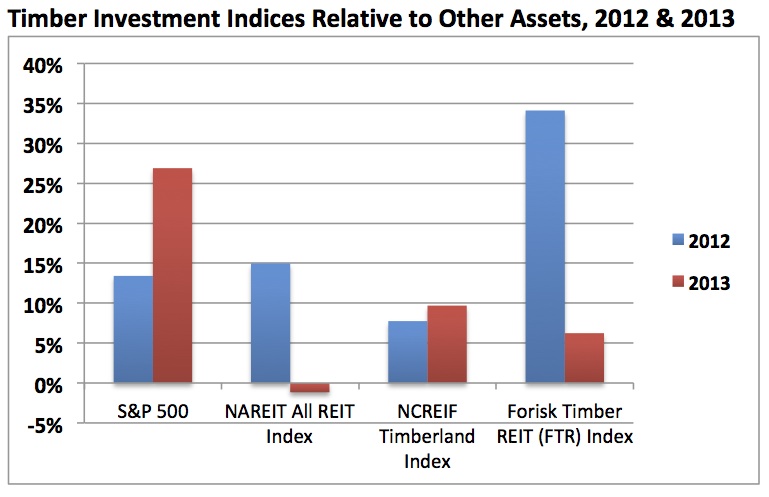NCREIF recently reported Q4 2013 total returns for private US timberlands of 5.92%. This total return number accounts for nearly two-thirds of the total 9.69% return for all of 2013. Big moves during the fourth quarter for the NCREIF Timberland Index remain a common occurrence as a disproportionate number of the acres tracked by the index report their appraised market values towards the end of the year. This reality of tracking timberland investment performance reduces the value and rigor of comparing quarterly results to other asset classes, while reinforcing the usefulness of annual performance metrics.
So let’s take a look and compare, for 2012 and 2013, the performance of indices tracking the S&P 500, all publicly-traded real estate investment trusts (NAREIT), private timberlands (NCREIF) and publicly-traded timberland-owning REITs (FTR). The timber REITs in the FTR Index include Plum Creek (PCL), Potlatch (PCH), Rayonier (RYN) and Weyerhaeuser (WY).
While publicly-traded timber REITs, as measured by the Forisk Timber REIT (FTR) Index, crushed the field in 2012 with returns of 34.12%, the S&P 500 captured the yellow jersey in 2013 with a 26.90% gain. The summary results, though capturing an arbitrary snapshot, remain consistent with the timberland investing thesis that direct ownership of timberlands provides superior capital preservation and diversification and stability, as reflected in balanced returns for 2012 and 2013. Alternately, public timber REITs offer superior liquidity and total returns over time with more risk as equity values can and will dive with the overall market.
Click here to learn about and register for “Applied Forest Finance” on February 10th in Atlanta, Georgia. The course details necessary skills and common errors associated with the financial and risk analysis of timberland and other forestry-related investments.


Leave a Reply